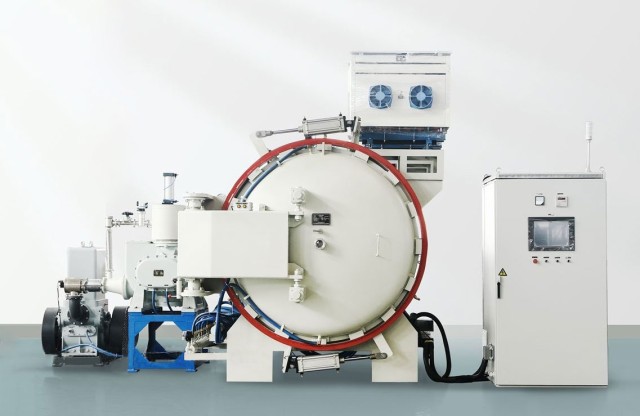真空烧结炉操作流程
通电前检查
在启动通电过程之前,必须执行一系列准备步骤,以确保真空烧结炉安全高效地运行。首先要检查每个控制开关是否处于 "关闭 "位置。这一预防措施可防止开关意外处于 "接通 "状态时发生意外电涌或设备故障。
接下来,将所有相关开关配置为手动模式。该模式允许人工直接监督和控制各种操作,从而提高安全性和精确度。此外,将功率调节设置为最低。这种保守的方法可以最大限度地降低功率突然波动的风险,以免损坏设备或影响烧结工艺的完整性。
确认这些初始设置后,开始启动机械泵。该泵在创造烧结过程所需的初始真空条件方面起着至关重要的作用。继机械泵之后,按照预定的工艺顺序启动扩散泵。扩散泵对于获得更高的真空度至关重要,而真空度是材料成功烧结的关键。
通过严格遵守这些预启动检查,操作员可以确保真空烧结炉为后续阶段的操作做好准备,从而提高安全性和效率。
测量炉子真空度
为确保真空烧结炉的正常运行,在启动加热过程之前测量并保持适当的真空度至关重要。真空计是这一过程中的重要工具,可提供炉内压力的实时数据。
关键真空度
| 真空类型 | 扩散泵 | 机械泵 |
|---|---|---|
| 极限真空 | 10^-6 托 | 20 微米汞柱 |
| 工作真空 | 10^-5 托 | 50-60 微米汞柱 |
抽真空时间
- 高真空交叉:约 10 分钟。
- 1 x 10^-4 托:约 15 分钟。
泄漏率注意事项
真空炉泄漏率应小于每小时 5 微米。这一泄漏率对于保持真空环境的完整性、确保窑炉清洁高效地运行至关重要。
在加热之前,操作人员必须确认真空规是否显示所需的真空度。这一步骤不容商量,因为它直接影响烧结过程的质量。此外,真空系统组件(包括密封件和泵)必须处于最佳状态,以达到并维持必要的真空度。
通过遵守这些准则,操作员可以确保熔炉在规定的参数范围内运行,从而获得成功和一致的烧结结果。
抽真空过程
要启动真空烧结炉的抽真空过程,必须遵循一系列细致的步骤,以确保系统的完整性和效率。
首先 关闭所有真空阀门 将炉腔与任何外部气压隔离。这一初步步骤对于防止空气突然涌入而影响抽真空过程至关重要。
下一步 启动机械泵 .该泵是在炉腔内形成初始真空的主要部件。机械泵的工作原理是不断地从炉腔中排除空气分子,从而降低内部压力。
机械泵运行后 缓慢打开低真空阀 .该阀门允许空气有控制地进入系统,这对于预萃取阶段至关重要。缓慢打开可确保炉体内的压力逐渐降低,从而防止任何机械冲击或损坏内部组件。
在此阶段,必须持续监控真空规。真空计可提供炉内压力的实时数据,操作人员可根据需要调整阀门开度,以达到所需的预抽真空度。
总之,抽真空过程包括一连串协调的操作:关闭所有真空阀门、启动机械泵、小心地打开低真空阀门以预抽取炉体。每个步骤都旨在确保平稳高效地抽真空,为后续的加热和烧结过程奠定基础。
打开真空阀
在炉体抽真空过程中,打开真空阀以便进行扩散泵抽气至关重要。这一步骤对于保持真空烧结过程的完整性和效率至关重要。
在对扩散泵进行加热之前,确保启动冷却水系统。这一预防措施对于防止过热和扩散泵的潜在损坏至关重要。冷却水系统起着保护作用,可确保泵在安全温度范围内运行。
概括地说,这一阶段的操作顺序包括
- 打开真空阀:当熔炉开始抽真空时,打开扩散泵的真空阀。
- 启动冷却水:在加热扩散泵之前,打开冷却水系统,确保其在安全参数范围内运行。
这种细致入微的方法可确保真空烧结过程顺利高效地进行,从而保障设备和最终产品的质量。
加热过程
在真空烧结炉的加热过程中,谨慎操作以保持最佳真空条件至关重要。首先要缓慢提高炉温。这种循序渐进的加热方式有助于稳定内部压力,防止突然的波动损坏设备或影响烧结过程。
如果真空度在任何时候下降到 1.5 Pa,必须立即停止加热过程。真空度下降可能表明系统内存在泄漏或其他问题。让炉子闲置,直到真空充分恢复。在此期间,密切监视真空表对于确保压力恢复到可接受的水平至关重要。
真空稳定后,即可恢复加热。建议在整个加热过程中继续密切监控真空度,以防止真空度进一步下降,并确保烧结环境的完整性。这种一丝不苟的方法不仅能保护设备,还能确保最终产品的质量和一致性。
手动加热
温度低于 200 ℃ 时,手动加热是首选方法。这种方法可以精确控制加热过程,确保逐步调整功率,防止任何可能超过次级额定电流的突然浪涌。逐步调节对于保持稳定的温度和防止炉子部件产生热应力至关重要。
当温度超过 200 ℃ 时,建议改用红外线加热进行自动控制。红外线加热可提供更有效、更稳定的热量分布,这对于在较高温度下保持烧结过程的完整性至关重要。这种转换可确保窑炉在最佳条件下运行,最大限度地提高效率和安全性。
冷却
在真空烧结炉运行的冷却阶段,必须采用系统的方法来确保设备的完整性和使用寿命。冷却过程可通过预设程序或手动关闭加热元件进行管理。这两种方法都需要仔细监控,以防止热应力和对炉子部件的潜在损坏。
对于选择预设程序的用户来说,必须确保程序配置正确,以逐渐降低温度。这种逐步降温的方式有助于防止热冲击,因为热冲击可能导致机械故障或熔炉结构出现裂缝。
如果选择手动冷却,操作员必须确保在适当的时候关闭加热元件。这一决定应基于炉子的温度和加工材料的具体要求。手动冷却需要敏锐的观察力和精确的时间安排,以避免过热或冷却不足,这两种情况都会对最终产品的质量产生不利影响。
无论选择哪种冷却方法,保持持续供水都是不可或缺的。供水对于冷却扩散泵和其他组件至关重要,可确保它们在冷却过程中不会过热。稳定的水流有助于有效散热,从而保护窑炉免受潜在的损坏。
总之,冷却阶段是真空烧结炉运行中一个微妙而又重要的部分。无论是通过预设程序还是手动控制,其目标都是实现受控的逐步降温,同时确保持续供水以保护设备。
真空烧结炉操作注意事项
炉子外观维护
保持真空烧结炉的清洁对于确保最佳的真空萃取效率至关重要。定期清洁不仅能防止灰尘和碎屑堆积,还能延长炉子部件的使用寿命。不使用时,建议将炉子存放在真空状态下。这种做法有助于保持真空密封的完整性,并防止任何大气污染物进入系统。
要保持窑炉的外观和功能,请遵循以下步骤:
- 定期清洁:对窑炉的内外表面进行例行检查和清洁。使用适当的清洁剂清除运行过程中可能积累的污垢或残留物。
- 真空存放:每当窑炉不运行时,应将其存放在真空环境中。这可以通过保持真空泵运转并确保所有阀门密封良好来实现。
- 检查密封件:定期检查真空密封件是否有任何磨损或损坏的迹象。立即更换任何有问题的密封件,以防止漏气影响真空抽取效率。
坚持这些维护措施,就能确保真空烧结炉保持最佳状态,随时准备高效运行。
真空系统维护
真空系统的维护对于确保真空烧结炉的使用寿命和效率至关重要。这包括定期检查和处理,这对防止污染物影响系统性能至关重要。其中一项重要的维护工作是在轴向密封部件上涂抹真空密封脂。这项工作应 每六个月 以确保密封件保持有效,并防止任何可能影响真空完整性的泄漏。
除了涂抹密封脂之外,其他维护措施也同样重要。例如 检查安装螺栓是否拧紧 并 检查任何异常噪音或振动 有助于及早发现潜在问题。确保在系统运行前安装好所有防护装置,并 检查油位和污染迹象 这也是日常维护清单的一部分。如果发现污染,必须及时换油,以防止进一步损坏。
对于粗加工泵,还应遵循其他维护步骤。这些步骤包括 检查皮带轮和皮带的松紧度是否合适 , 每天排空排气管过滤器 以及 检查通风是否正常 .此外、 每六个月清洗一次储油罐、阀台和电磁阀,这对保持系统的效率和可靠性至关重要。 对保持系统的效率和可靠性至关重要。
坚持这些维护措施,可以大大提高真空烧结炉的安全性、产量、可靠性和可持续性,确保其在最佳性能下运行。
热电偶系统维护
为确保真空烧结炉热电偶系统的使用寿命和准确性,定期维护至关重要。其中一项重要的维护工作是旋转热电偶座。旋转热电偶座有助于均匀分布磨损,防止任何可能影响温度读数精度的局部损坏。建议每六个月进行一次旋转。
此外,扩散泵油需要定期加注。随着时间的推移,油会变质或受到污染,从而影响扩散泵的性能。重新注油不仅能保持泵的效率,还能延长其使用寿命。作为六个月例行维护的一部分,请确保将扩散泵油补充到适当的水平。
| 维护任务 | 频率 | 目的 |
|---|---|---|
| 旋转热电偶座 | 每 6 个月 | 均匀分布磨损,保持温度读数的准确性 |
| 补充扩散泵油 | 每 6 个月 | 保持泵的效率,延长使用寿命 |
通过坚持这些维护措施,您可以确保热电偶系统保持可靠,并使真空烧结炉以最佳性能运行。
观察窗维护
真空烧结炉每次运行后,都必须清洁观察窗玻璃。这种做法可确保视野清晰,这对监控真空烧结炉的内部过程至关重要。观察窗通常由高质量的硼硅玻璃制成,会积累炉内高温环境中的灰尘、油和其他残留物。
为了保持最佳的可视性,请按照以下步骤进行清洁:
-
关闭并冷却:确保窑炉完全关闭并冷却到室温。这样可以防止任何烧伤或损坏玻璃的风险。
-
选择适当的清洁剂:使用适合高温玻璃的非研磨性清洁剂。避免使用任何可能与玻璃发生反应或留下条纹的化学品。
-
用软布轻轻擦拭:用柔软、不起毛的布轻轻擦拭玻璃表面。少用清洁剂,以避免清洁剂顺着玻璃窗流到炉子里。
-
检查损坏情况:清洁后,检查玻璃是否有划痕、裂缝或其他损坏。如有任何问题,请向维护人员报告,以便及时维修或更换。
定期维护观察窗不仅可以清楚地看到炉子内部的情况,从而提高安全性,还可以确保观察窗本身的使用寿命。


























